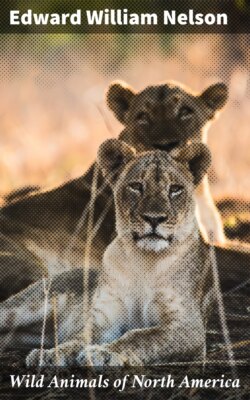Читать книгу Wild Animals of North America - Edward William Nelson - Страница 33
На сайте Литреса книга снята с продажи.
PLAINS COYOTE, OR PRAIRIE WOLF (Canis latrans)
ОглавлениеTable of Contents
Western North America is inhabited by a peculiar group of small wolves, known as coyotes, this being a Spanish corruption of the Aztec name coyotl. They range from northern Michigan, northern Alberta, and British Columbia south to Costa Rica, and from western Iowa and Texas to the Pacific coast. As a group they are animals of the open plains and sparsely wooded districts, ranging from sea-level to above timber-line on the highest mountains. They are most at home on the wide brushy or grassy plains of the western United States and the table-lands of Mexico.
Within their great area coyotes have developed several distinct species and a number of geographic races, distinguished by differences in size, color, and other characteristics. Some attain a size almost equaling that of the gray wolf, while others are much smaller.
They are less courageous and have less of the social instinct than gray wolves, and on the rare occasions when they hunt in packs they form, no doubt, a family party, including the young of the year. They appear to pair more or less permanently and commonly hunt in couples. The young, sometimes numbering as many as fourteen, are born in a burrow dug in a bank, or in a den among broken rocks and ledges. Young animals are readily tamed, and it is entirely probable that some of the dogs found by early explorers among western Indians may have descended from coyotes.
Coyotes are a familiar sight to travelers in the wildest parts of the West. Here and there one is seen trotting through the sagebrush or other scrubby growth, or stopping to gaze curiously at the intruder. If suddenly alarmed, they race away across the plains with amazing speed. At night their high-pitched, wailing howls voice the lonely spirit of waste places.
With the growth of settlement in the West and the steady decrease of large and small game, coyotes have become more and more destructive to poultry and all kinds of live stock. As a result, every man’s hand is against them, reinforced by gun, trap, and poison. Despite years of this persistent warfare, their acute intelligence, aided by their extraordinary fecundity, has enabled them to hold their own over a great part of their original range. Their depredations upon live stock have been so great that many millions of dollars have been paid in bounties for their destruction.
This method of control has proved so ineffective, however, that the Federal Government has engaged in the task of suppressing them, together with the other less numerous predatory animals of the West, and has placed about 300 hunters in the field for this purpose. The complete destruction of coyotes would, no doubt, upset the balance of nature in favor of rabbits, prairie-dogs, and other harmful rodents, and thus result in a very serious increase in the destruction of crops.
The coyote supplies much interest and local color to many dreary landscapes and has become a prominent figure in the literature of the West. There it is usually symbolic of shifty cunning and fleetness of foot. Whatever his faults, the coyote is an amusing and interesting beast, and it is hoped that the day of his complete disappearance from our wild life may be far in the future.
